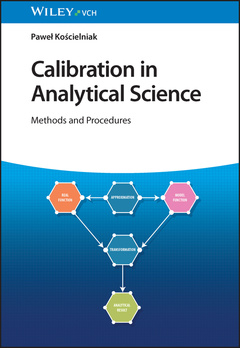Calibration in Analytical Science Methods and Procedures
Auteur : Kościelniak Paweł

Designed to help analytical chemists save time and money by selecting the best calibration method in a quality control, substance monitoring, or research setting
Univariate analytical calibration is a vital step in every chemical procedure that involves determining the identity or concentration of a particular substance. Depending on the type of instrument and measurement, analytical chemists need to follow different calibration strategies and protocols to ensure their instruments yield accurate readings.
Calibration in Analytical Science systematically classifies and describes a wide range of calibration methods and procedures based on mathematical and empirical models for use in qualitative and quantitative analysis. Focusing on the chemical aspects of analytical calibration, this much-needed reference uses a set of equipment-independent terms and definitions that are easily transferable to the calibration strategies of any analytical process. The theoretical basis for calibration of each analytical mode is described and applied to common analytical tasks of increasing levels of difficulty and complexity. Throughout the book, the author illustrates how to combine different calibration approaches to create new calibration strategies with extended capabilities.
- Describes different calibration methods and procedures for determining the nature and quantity of sample components in different ways
- Classifies various calibration methods in both qualitative and quantitative analysis
- Demonstrates how the random and systematic errors of an analytical method can be minimized by the proper calibration strategy
- Discusses current theoretical and methodological questions in calibration research
- Highlights how calibration approaches can diagnose, evaluate, and eliminate analytical errors
- Includes a concluding chapter on the contribution of calibration to the greening of analytical chemistry
Calibration in Analytical Science: Methods and Procedures is a must-have reference for analytical chemists working in academia and industry, chemists of various specialties involved in chemical analysis, and advanced undergraduate and graduate students taking courses in advanced analytical chemistry.
Preface ix
1 Calibration Fundamentals 1
1.1 Analytical Context 1
1.2 Principles of Analytical Calibration 2
1.3 Calibration Standards and Models 5
1.4 Calibration Procedures and Methods 7
1.5 Calibration in the Context of Measurement Errors 8
1.5.1 Uncontrolled Analytical Effects 9
1.5.2 Elimination and Compensation of Uncontrolled Effects 11
1.6 Calibration in Qualitative Analysis 14
1.7 Calibration in Quantitative Analysis 18
1.8 General Rules for Correct Calibration 22
References 24
2 “Calibration-Free” Analysis 25
2.1 Novel Approach 25
2.2 Empirical Calibration 26
2.3 Theoretical Calibration 30
2.3.1 Fixed Models 30
2.3.2 Flexible Models 36
References 45
3 Calibration Methods in Qualitative Analysis 47
3.1 Classification 47
3.2 External Calibration Methods 49
3.2.1 External Standard Method 49
3.2.2 Reference Sample Method 59
3.3 Internal Calibration Methods 71
3.3.1 Internal Standard Method 71
3.3.2 Indirect Method 75
3.4 Standard Addition Method 80
References 83
4 Introduction to Empirical Calibration in Quantitative Analysis 85
4.1 Classification 85
4.2 Formulation of Model Functions 86
4.3 Examination of Interference Effect 93
4.4 Mathematical Modeling of Real Function 98
References 100
5 Comparative Calibration Methods 103
5.1 External Calibration Methods 103
5.1.1 External Standard Method 103
5.1.1.1 Modified Procedures 110
5.1.2 Dilution Method 115
5.2 Internal Calibration Methods 125
5.2.1 Internal Standard Method 125
5.2.2 Indirect Method 133
References 141
6 Additive Calibration Methods 143
6.1 Basic Aspects 143
6.2 Standard Addition Method 144
6.2.1 Extrapolative Variant 144
6.2.1.1 Modified Procedures 155
6.2.2 Interpolative Variants 162
6.2.3 Indicative Variant 167
6.3 Titration 172
6.4 Isotope Dilution Method 180
6.4.1 Radiometric Isotope Dilution 182
6.4.2 Isotope Dilution Mass Spectrometry 189
6.4.2.1 Modified Procedures 197
References 199
7 Calibration in Nonequilibrium Conditions 203
7.1 Flow Injection Analysis 203
7.1.1 Manipulation Techniques 205
7.1.2 Gradient Technique 212
7.2 Kinetic Analysis 220
References 231
8 Complex Calibration Approaches 233
8.1 Extrapolative Methods 233
8.1.1 Extrapolative Indirect Method 234
8.1.2 Extrapolative Internal Standard Method 239
8.1.3 Extrapolative Dilution Method 244
8.2 Mixed Methods 252
8.3 Combined Methods 256
8.3.1 Integrated Calibration Methods 256
8.3.1.1 Simple Integrated Method 256
8.3.1.2 Complementary Dilution Method 261
8.3.2 Generalized Calibration Strategy 270
8.3.2.1 Versatile Flow Injection Calibration Module 276
8.3.3 Standard Dilution Analysis 280
References 286
9 Calibration Approaches for Detection and Examination of Interference Effects 289
9.1 Introduction 289
9.2 Simple Procedures for Detection and Examination of Interference Effects 290
9.3 Detection and Compensation of Additive Interference Effect 295
9.3.1 Interpolative Procedure 297
9.3.2 Extrapolative Procedure 301
9.3.3 Integrated Procedure 308
References 311
10 Calibration-Based Procedures for Correction of Preparative Effects 313
10.1 Introduction 313
10.2 Specific Procedures 314
10.3 Surrogate Recovery Method 316
10.3.1 Reliability of the Method 318
10.3.2 Interpretations of the Method 321
10.3.3 Recovery vs. Interference Effect 324
10.3.4 Recovery vs. Speciation Effect 329
References 333
11 Calibration-Related Applications of Experimental Plans 335
11.1 Introduction 335
11.2 Examination of Interference Effects 337
11.3 Modeling of Real Functions 342
11.4 Multicomponent Analysis 347
References 356
12 Final Remarks 359
References 365
Index 367
Pawe³ Kocielniak, PhD, is Full Professor employed in the Department of Analytical Chemistry at Jagiellonian University, Krakow, Poland. He is a member of the Committee of Analytical Chemistry of the Polish Academy of Sciences, and is the author, co-author, and editor of more than 300 scientific articles, books, and book chapters. Professor Koscielniak’s main scientific interests include flow analysis, forensic chemistry, and environmental analysis with a special focus on analytical calibration, examination and elimination of interference effects, and optimization and validation of analytical procedures.
Date de parution : 02-2023
Ouvrage de 384 p.
17x24.4 cm
Thème de Calibration in Analytical Science :
Mots-clés :
analytical chemistry; univariate analytical calibration; analytical calibration methods; analytical calibration procedures; calibration methods in qualitative analysis; calibration methods in quantitative analysis; analytical effects; interference effects; integrated calibration methods; combined calibration methods


